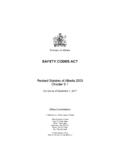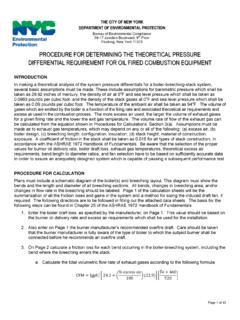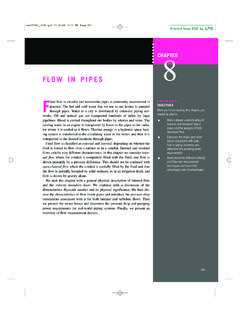Transcription of Guidance on Safe Operation of Boilers - CEA :: Home
1 Guidance on safe Operation of Boilers Ref: BG01. A joint document by the Safety Assessment Federation and Combustion Engineering Association produced in consultation with the Health & Safety Executive. Foreword by Health & Safety Executive This document, Guidance for safe Operation of Boilers (BG01) has been developed and written by Safety Assessment Federation (SAFed) and the Combustion Engineering Association (CEA) in consultation with other stakeholders within the boiler systems industry to help managers, designers and operators of new and existing boiler systems make health and safety improvements in the boiler systems industry. Acknowledgements SAFed and CEA acknowledges the support of the Health and Safety Executive in producing this Guidance . Safety Assessment Federation (SAFed) is a trade association, which represents the independent engineering inspection and certification industry in the UK. SAFed's primary aim is to promote safety and reduce accidents in the workplace.
2 SAFed supports corporate social responsibility through compliance with the law and adopting best industry practice. Combustion Engineering Association (CEA) is an educational charity, which promotes the science of combustion engineering in the commercial/industrial sector. CEA is concerned with industry good practice and the safe and efficient Operation of combustion related plant and equipment. 2011 Safety Assessment Federation (SAFed) and Combustion Engineering Association (CEA). Guidance on safe Operation of Boilers - Edition 1 - October 2011. Guidance on safe Operation of Boilers Ref: BG01. Table of Contents: Page 1 INTRODUCTION 4. 2 SCOPE 4. 3 LEGISLATION 5. 4 LEGAL RESPONSIBILITIES 8. 5 PERSONNEL AND RESPONSIBILITIES 11. 6 TRAINING 13. 7 DESIGN AND INSTALLATION 15. 8 boiler Operation 23. 9 MAINTENANCE, REPAIR AND MODIFICATION 26. 10 PERIODIC EXAMINATION OF Boilers 28. 11 ENERGY AND ENVIRONMENT 29. 12 REFERENCES 30. 13 ANNEXES 32. DEFINITIONS 32. TYPICAL LOG SHEETS FOR boiler TESTS 34.
3 Guidance on safe Operation of Boilers - Edition 1 - October 2011 3 of 40. 1 INTRODUCTION. Guidance for the safe Operation of Boilers (Ref: BG01) is a Guidance document intended to assist the managers, designers, operators, maintenance personnel and Competent Persons (CP) of new and existing boiler systems in addressing the following issues: The safe use and Operation of the boiler installation. Determining the adequate supervision and maintenance (levels and competence). requirements that is consistent with the installed plant and its location. Reducing the likelihood of explosion, or other dangers, from events such as: Loss of feed water or low water level. Over-pressure. Overheating due to excessive scale. Using efficient boiler Operation to avoid the excessive pressure/thermal cycles and load swings which can accelerate boiler fatigue or failure. Using the proper treatment and monitoring of the feedwater and condensate to: Minimise corrosion and scale and avoid carry-over of water with the steam which in turn can cause water-hammer.
4 Compliance with the various legal requirements, in particular that for periodic examination by a CP in accordance with a written scheme of examination (WSE).. 2 SCOPE. This document applies to those industrial & commercial steam and hot water boiler plant operating at a working pressure of between and 32 bar gauge and working temperature between 110 C to 400 C. The following Boilers are specifically excluded from the scope of this Guidance Document: Water tube Boilers . Process Boilers with a capacity exceeding: 30 tonnes steam per hour. 25MW. 32 bar gauge working pressure. Domestic, commercial Boilers smaller than 70kW. Electric immersion, steam coil heated and electrode Boilers . Manually operated Boilers ( those requiring constant human intervention). This document also excludes from its scope any consequences arising from incorrect steam pressure delivery from the boiler . Guidance on safe Operation of Boilers - Edition 1 - October 2011 4 of 40. 3 LEGISLATION. boiler systems are required to comply with different legislation, including a number of health and safety regulations, which aim at ensuring that new and existing boiler systems are continually operated and maintained in a safe manner.
5 The principal sets of health and safety legislation that apply to the use of boiler systems covered by this Guidance are: The Management of Health & Safety at Work Regulations 1999 (MHSWR). The Pressure Equipment Regulations 1999 (PER). The Pressure Systems Safety Regulations 2000 (PSSR). The Provision and Use of Work Equipment Regulations 1998 (PUWER) and The Dangerous Substances and Explosive Atmospheres Regulations 2002 (DSEAR). (DSEAR may apply in some cases and will be briefly discussed with PER.). With the exception of PER, all the regulations listed above are supported by Approved Codes of Practice (ACOP) and Guidance produced by the Health and Safety Executive (HSE), and available as free downloads from The Management of Health and Safety at Work Regulations 1999 (MHSWR). MHSWR apply to every employer and self-employed person who carries out any work activity whether or not they own or control a pressure system (all future references to employers in this Guidance should be read to include self-employed persons).
6 They impose a duty to manage all risks from any work activity, not only within the workplace itself, but also any risks to all persons (including any non employees) who may be affected by the activity in question. Regulation 3 requires the completion of a suitable and sufficient risk assessment of the work activity in order to properly identify and adequately manage any risks. This is of central importance. The risk assessment should identify sensible measures to control identified risks that may otherwise result in injury or danger. Risk assessments for boiler systems are covered in more detail in the next chapter. The Pressure Equipment Regulations 1999 (PER). All new and substantially modified pressure equipment (including steam raising plant) come within scope of PER and they must comply with its requirements before they may be supplied for use. PER applies to the design, manufacture and conformity assessment of pressure equipment and assemblies of pressure equipment with a maximum allowable pressure > bar.
7 The Regulations do not apply to: Excluded pressure equipment and assemblies (specified in Schedule 1 to PER). Pressure equipment and assemblies placed on the market before 29 November 1999. Pressure equipment or assemblies placed on the market on or before 29 May 2002 if they comply with the safety provisions in force in the UK on 29 November 1999 and do not bear a CE marking (unless required by another Community Directive or any indication of compliance with PED). Guidance on safe Operation of Boilers - Edition 1 - October 2011 5 of 40. Schedule 2 of PER details the essential safety requirements (ESR) that qualifying vessels must satisfy. Additionally, there are details of how the different products are classified, the technical requirements that must be satisfied, and the conformity assessment procedures that must be followed. To comply with the ESRs the manufacturer must either produce a technical file that addresses each ESR in turn, or manufacture the equipment using standards that have been listed in the EU's Official Journal which give a presumption of conformity' to specific ESRs.
8 The Department for Business, Innovation and Skills (BIS) has produced a very useful guide to PER. ( ) There is an easy-to-use flow chart (Annex C) showing how equipment should be classified depending on, for example, what it is designed to contain and the operating pressure. This includes the conformity assessment procedure to be followed before placing the equipment on the market. Equipment supplied for use in a potentially explosive atmosphere must also satisfy the relevant requirements of the Equipment and Protective Systems Intended for Use in Potentially Explosive Atmospheres Regulations 1996. The owner of the system may assist the manufacturer by providing information from an assessment of the probability of the presence and the likely persistence of a potentially explosive atmosphere in the proposed working environment as set out in the Dangerous Substances & Explosive Atmospheres Regulations 2002 (DSEAR) assessment. Pressure Systems Safety Regulations 2000 (PSSR).
9 PSSR set out the main legislative requirements to ensure the continued safety of the pressure systems (which includes steam Boilers ) in use. PSSR applies to two clearly defined categories of people (duty holders). These include: Owner' This means an employer or self-employed person who owns a pressure system. Where the employer who owns the system does not have a place of business in Great Britain, or an agent in Great Britain who would take responsibility, then the user (see below) will be responsible. User' This means the employer or self-employed person who has control of the Operation of the pressure system. The distinction between owner' and user' can be important in certain circumstances in determining the duty holder responsible for ensuring compliance with certain regulations under PSSR. However, in general, owners carry more responsibility in relation to mobile systems, while users have responsibilities in relation to installed systems. Package Boilers are considered to be installed systems for the purposes of the regulations.
10 The owner/user of the boiler is responsible for complying with the following requirements of PSSR: safe Operating Limits (SOL) have been set and are not adjusted without informing the CP and manufacturer where appropriate. The system is never operated unless a current Written Scheme of Examination (WSE) is in place. Any requirements of this scheme a report of the last examination must also be satisfied (Regulations 8 & 9). The items identified in the WSE are examined by a CP in accordance with the requirements of the scheme. Guidance on safe Operation of Boilers - Edition 1 - October 2011 6 of 40. All repairs & modifications must be carried out by people suitably competent in such work (Regulation 13, PSSR, ACOP Para 180). The details of such work must be retained. The effects of modifications and repairs should also be assessed to determine whether the WSE needs review. The statutory technical documentation and other records must be kept and where required, be made available for examination.



